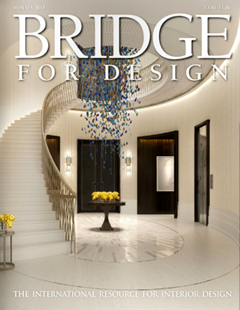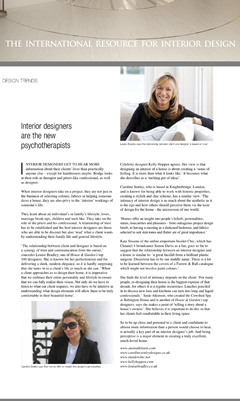Bridge for design

INTERIOR DESIGNERS GET TO HEAR MORE information about their clients’ lives than practically anyone else - except for hairdressers maybe. Bridge looks at their role as therapist and priest-like confessional, as well as designer.
When interior designers take on a project, they are not just in the business of selecting colours, fabrics or helping someone dress a house, they are also privy to the ‘interior’ workings of someone’s life.
They learn about an individual’s or family’s lifestyle, loves, marriage break-ups, children and such like. They take on the role of the priest and his confessional. A relationship of trust has to be established and the best intenor designers are those who are able to be discreet but also ‘read’ what a client wants by understanding their family life and general lifestyle.
‘The relationship between client and designer is based on a synergy of trust and communication from the outset. ’ concedes Louise Bradley, one of House & Gardens top 100 designers. She is known for her perfectionism and for delivering a sleek, modem elegance, so it is hardly surprising that she tunes in to a client’s life as much as she can. ‘When a client approaches us to design their home, it is imperative that we embrace their entire personality and lifestyle to ensure that we can fully realise their vision. Not only do we have to listen to what our client requires, we also have to be intuitive in understanding what design elements will allow them to be truly comfortable in their beautiful home’.
Celebrity designer Kelly Hoppen agrees. Her view is that designing an interior of a house is about creating a ‘ sense of feeling. It is more than what it looks like’. It becomes what she describes as a ‘melting pot of ideas’.
 Caroline Senley, who is based in Knightsbndge, London, and is known for being able to work with histone properties, creating a stylish and chic scheme, has a similar view ‘The intimacy of interior design is as much about the aesthetic as it is the ego and how others should perceive them via the taste of design for the home - the microcosm of our world'.
Caroline Senley, who is based in Knightsbndge, London, and is known for being able to work with histone properties, creating a stylish and chic scheme, has a similar view ‘The intimacy of interior design is as much about the aesthetic as it is the ego and how others should perceive them via the taste of design for the home - the microcosm of our world'.
‘Homes offer an insight into people’s beliefs, personalities, status, insecunties and pleasures - from outrageous project design briefs, to having a meeting in a darkened bedroom, and fabnes selected to suit skin tones and flatter are of great importance ’
Kate Sissons of the online emponum Insider Chic, which has Channel 4 broadcaster Simon Davis as a fan, goes so far to suggest that the relationship between an interior designer and a house is similar to ‘a great facelift from a brilliant plastic surgeon. Discretion has to be our middle name. There is a lot to be learned between the covers of a Farrow & Ball catalogue which might not involve paint colours’.
She finds the level of intimacy depends on the client. ‘For many people, re-designing their house is the biggest expense of that decade, for others it is a regular occurrence. Lunches penciled in to discuss new loos and kitchens can turn into long and liquid confessionals’. Susie Atkinson, who created the Cowshed Spa at Babington House and is another of House & Gardens top designers, says she makes a point of ‘telling a story about a house’s owners’. She believes it is important to do tins so that her clients feel comfortable in their living space.
So to be up close and personal to a client and confidante to almost more information than a person would choose to hear, is actually a key part of an interior designer’s job. And being perceptive is a major element in creating a truly excellent, much-loved home.
